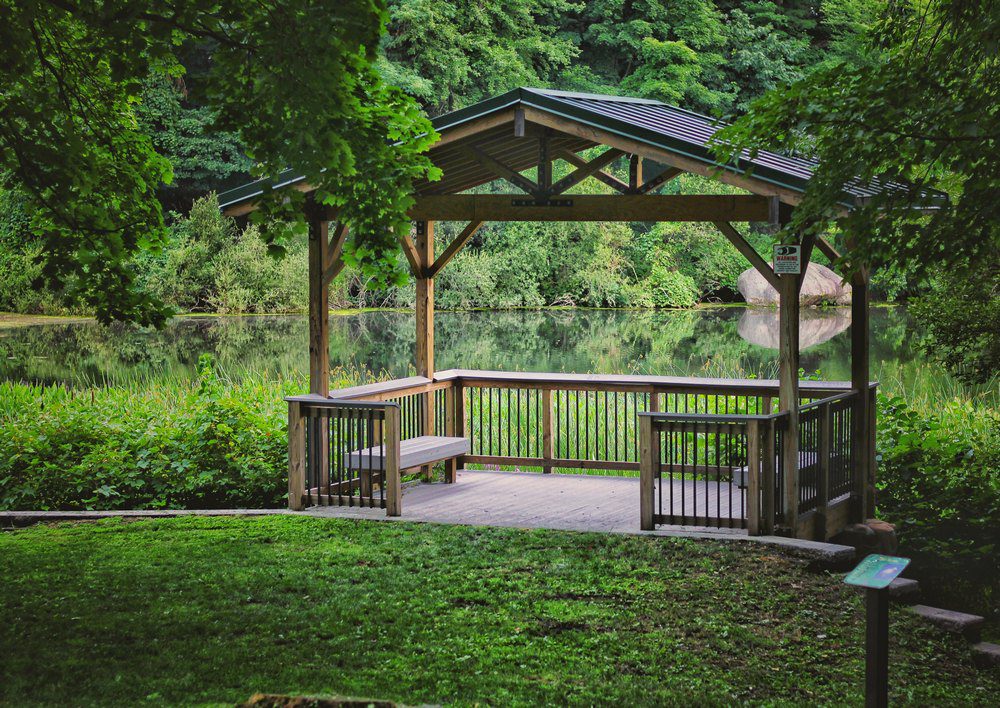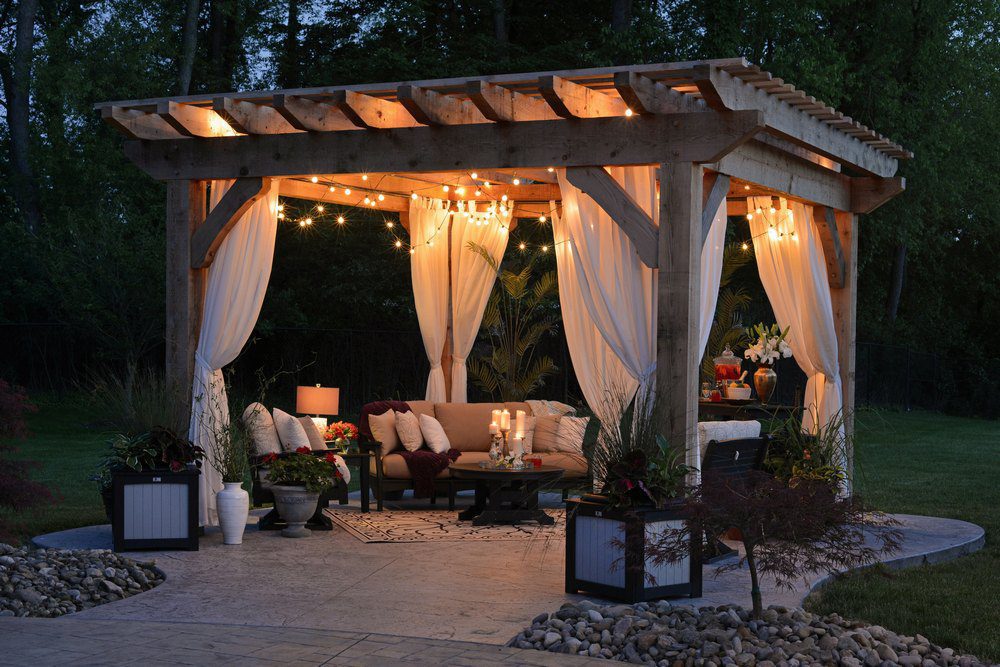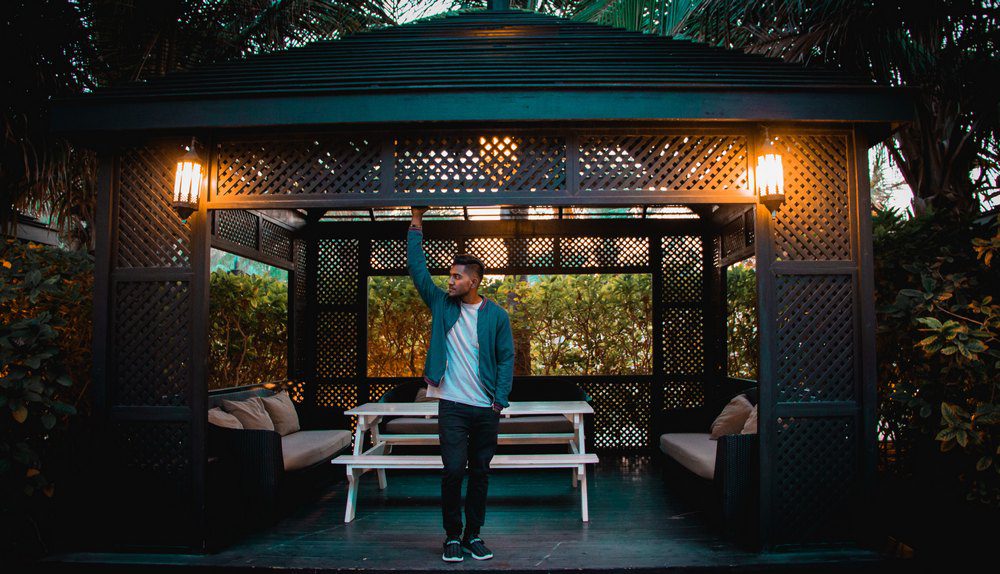Last Updated on February 23, 2024 by teamobn

There are endless options and ideas that homeowners looking to improve their outdoor living space can leverage. While some prefer excellent landscaping, bright-colored flowers, and plants, others think of an outdoor kitchen, fireplace, and alternative installations.
Outdoor gazebos are increasingly becoming a popular option for homeowners who want an outdoor structure with additional functionality. Backyard gazebos can be constructed in different styles and from various materials. If you are an experienced handyman with great construction skills, below are insightful tips for positioning and sprucing up your gazebo.
Contents
- 1 Picking the Best Spot for Gazebo in Your Backyard
- 2 Design Tips for Sprucing Your Backyard Gazebo
- 3 Choosing the Right Materials
- 4 Gazebo Privacy Solutions
- 5 FAQ on Construction Tips for Your Backyard Gazebo
- 5.1 What materials are best for building a backyard gazebo?
- 5.2 How can I add privacy to my backyard gazebo?
- 5.3 What are some eco-friendly options for gazebo construction?
- 5.4 How do I choose the right location for my gazebo in the backyard?
- 5.5 Can I install a gazebo by myself?
- 5.6 How can I ensure my gazebo is safe and durable?
- 5.7 Are there any legal considerations for building a gazebo?
- 5.8 How can I light up my gazebo for evening use?
- 5.9 What furnishings work best in a gazebo?
- 6 Endnote
Picking the Best Spot for Gazebo in Your Backyard
Besides having the best pavilion design, you should pick the best spot to build your gazebo in your backyard for various reasons. Positioning your gazebo perfectly allows you to maximize its use. However, where you place the gazebo primarily depends on the available backyard space.
A big backyard offers more options, while a small one means you’ll have to sacrifice other outdoor structures for the gazebo. You should consider the following when deciding where to construct the gazebo.
1. Purpose or Functionality
You should know the intended use or purpose of the pavilion before picking a spot. Homeowners prefer gazebos to pergolas because they provide protection from extreme weather, offer sheltered relaxation, and can be used in many ways in all seasons.
The intended reason for construction will influence its positioning. For instance, if you want a gazebo to protect you from harsh weather, consider building it close to the house. Similarly, if you want a private place to relax peacefully, find a secluded area in your backyard.
Still, you should determine the time of day you’ll mostly use the gazebo. If you are a morning person and enjoy watching the morning sun as you take your coffee, find a spot that is directly in line with the rising sun.
2. Available Space
You should design your gazebo to fit the available backyard space. If your garden is small to medium-sized, size your gazebo accordingly. Ideally, backyard constructions, including the deck and patio, shouldn’t cover more than a quarter of the available ground space.
Homeowners with large backyards can choose their dream gazebo designs. The best place to position a gazebo in a small backyard is against the wall or in a corner. While gazebos don’t take up much space, installing them at the center blocks much space.
You should also consider a square-shaped gazebo design to maximize the space.
3. Location
You should consider the lay of your backyard when picking the perfect spot for your gazebo. Survey various parts of your garden and evaluate the ground level, foundation, and possible obstructions. You can take advantage of raised areas, as they provide better views.
Little ground dips are also perfect for those who need privacy. Trees are the other determining factor. Shrubs and trees can provide good shade and privacy. The only challenge is some trees with superficial roots can damage the foundation.
Tree branches can also fall and destroy your gazebo. On the other hand, the structure can affect the plant’s ability to grow.
Design Tips for Sprucing Your Backyard Gazebo
Having picked the perfect position for your gazebo, you should work with a professional gazebo builder and contractor for the construction process. The following additional features can make your structure unique:

1. Add Some Light to Your Gazebo
Lighting is a crucial element that breathes life into your gazebo and any other outdoor structure. Some of the best lighting types for such an outdoor space include:
- String lights – Festoon or string lights are popular outdoor lights. They are warm, affordable, and stylish. However, you should choose LED light bulbs for their durability and low energy consumption.
- Fairy lights – These can be placed horizontally, vertically, or outside the gazebo. Fairy lights have small light bulbs that add warmth and create a relaxing atmosphere.
- Candle lights – These create a warm and intimate environment, especially if you prefer dining outside. They also produce pleasant aromas, depending on your preferred scent. They are best paired with hanging flowers.
2. Furnish Your Gazebo
With proper lighting in place, you should look into furnishing your gazebo. Some of the best options include:
- Chair and sofas – Rattan-effect chairs and sofas add extra style and comfort to the space. Corner sofa sets are ideal if your gazebo can accommodate many people.
- Throw pillows – Throws are another practical addition, especially when unwinding in the evening. They are also visually pleasing and perfectly complement chairs and sofas. Choose durable, breathable, and waterproof materials.
- Tables – Opt for small, circular outdoor tables or picnic tables if your gazebo has limited space. Adding a perfectly sized table extends the functionality of your outdoor space.

3. Accessorize the Gazebo
As mentioned, this structure is a perfect relaxation space. You should consider accessorizing it through:
- Speakers – Sound systems and speakers are perfect decorative accessories that can bring life into your gazebo. You can choose from several options, including color-changing LED and solar Bluetooth speakers.
- Wind chimes – You can also accessorize the space creatively using wind chimes. The calming and therapeutic sound of wind chimes is perfect for unwinding.
4. Add Some Color to Your Gazebo
The best way to make your gazebo exude vibrancy is by adding some color. Fortunately, you can achieve this in many ways, such as:
- Installing lanterns – The many types of lanterns can make it challenging to find the best option. Bottle lanterns are stylish and give your gazebo a rustic feel. Choose red, green, purple, or orange bottle lanterns for some color variance. Jar and hanging paper lanterns are also excellent options.
- Outdoor rug – You can use an outdoor rug to extend your living space. Choose a multicolored rug with geometric-inspired designs for a better appeal.
- Hanging planters – Hanging different plants also adds color to your gazebo. The bright pink geraniums, red begonias, or pink fuchsias are excellent choices.
Choosing the Right Materials
Selecting the optimal materials for your backyard pavilion is crucial in ensuring its longevity, functionality, and aesthetic appeal. The choice of materials will significantly influence the structure’s maintenance requirements, durability against weather conditions, and how well it complements your outdoor living space.
Below, we explore various materials to consider when constructing your outdoor pavilion, highlighting the benefits and drawbacks of each to help you make an informed decision.
Wood
Natural Appeal: Wood offers a classic, timeless look that easily blends with most garden landscapes. Its natural texture and color variations can enhance the rustic charm of your outdoor space.
Types and Durability: Cedar, redwood, and pressure-treated pine are common choices. Cedar and redwood are naturally resistant to decay, insects, and weather damage, while pressure-treated pine is an economical option that has been chemically treated to resist rot and pests.
Maintenance Needs: Regular staining or sealing is required to maintain its appearance and prolong its life.
Metal
Modern and Sturdy: Metals, such as aluminum and steel, provide a sleek, contemporary look. They are highly durable and can withstand severe weather conditions with minimal upkeep.
Aluminum: Lightweight and rust-resistant, aluminum is ideal for areas prone to heavy rain or humidity. It’s also relatively maintenance-free, though it may require periodic painting to prevent fading.
Steel: Heavier and more robust than aluminum, steel offers increased durability and stability but must be treated to prevent rust.
Vinyl (PVC)
Low Maintenance and Versatility: Vinyl pavilions are becoming increasingly popular due to their low maintenance requirements and versatility in design. They can mimic the look of wood without the associated upkeep.
Durability: Resistant to rot, insects, and weather damage, vinyl is an excellent option for a long-lasting structure. It does not require painting or staining, though occasional cleaning with soap and water is recommended to maintain its appearance.
Color and Style Options: Available in various colors and styles, vinyl allows for a high degree of customization to match your garden’s aesthetic.
Composite
Blend of Materials: Composite materials combine wood fibers and plastic to create a durable and low-maintenance option. It offers the natural appearance of wood with the added benefits of plastic.
Weather and Insect Resistance: Composites are designed to resist fading, staining, rot, and insects, making them an excellent choice for a hassle-free pavilion.
Eco-Friendly: Many composite materials are made from recycled components, making this option appealing for environmentally conscious homeowners.
Stone or Brick
Elegance and Durability: For those seeking a more permanent, elegant structure, stone or brick pavilions offer unmatched durability and a classic aesthetic that can elevate any garden design.
Customization: While more expensive, stone and brick allow for unique customization options. These materials can be used solely or combined with other materials, such as wood or metal, to create a distinctive look.
Maintenance: Aside from occasional cleaning, stone and brick require little maintenance and are incredibly resilient against weather and time.
Choosing the right material for your outdoor pavilion is a decision that impacts not only the project’s initial cost but also its ongoing maintenance and how it ages over time. Consider your climate, budget, and style preference when selecting materials to ensure your pavilion remains a beloved part of your outdoor living space for years to come.
Gazebo Privacy Solutions
Creating a private retreat in your backyard sanctuary involves implementing strategic privacy solutions for your gazebo. Privacy features not only enhance the seclusion and comfort of your outdoor space but also add an element of aesthetic appeal. Whether your garden pavilion is a hub for quiet relaxation or lively social gatherings, these solutions can help you achieve a more intimate setting.
Below, we explore various methods to increase privacy in your garden structure, ensuring your tranquil moments remain undisturbed.
Lattice Panels
Versatile and Decorative: Lattice panels are a popular choice for adding privacy to garden pavilions. These crisscrossed wooden panels not only obstruct prying eyes but also serve as a decorative element that can be integrated into any garden style.
Support for Climbing Plants: Lattice panels can act as a trellis for climbing plants, providing a natural green screen that enhances privacy and beauty.
Privacy Screens
Portable and Flexible: Freestanding privacy screens are an excellent option for those seeking a non-permanent solution. These screens can be moved and adjusted as needed, offering flexibility in layout and design.
Variety of Materials: Available in wood, metal, fabric, and more, privacy screens can complement the existing design of your outdoor pavilion while providing an effective barrier against outside visibility.
Outdoor Curtains
Soft and Elegant: For a softer touch, outdoor curtains can be hung around the perimeter of your gazebo. These add an elegant flair and allow for adjustable levels of privacy and protection from the elements.
Weather-Resistant Fabrics: Opt for durable, weather-resistant fabrics that can withstand the elements while offering a cozy, secluded ambiance.
Strategic Planting
Natural Barrier: Planting tall shrubs, trees, or bamboo around your gazebo creates a living wall that enhances privacy and integrates your structure into the natural landscape.
Considerations for Growth: Select plants suitable for your climate and garden space, and consider their growth rate and mature size for optimal privacy and minimal maintenance.
Fencing
Solid and Secure: A fence surrounding your garden structure provides a solid barrier that guarantees privacy. This can range from decorative wooden fencing to more substantial, privacy-focused designs.
Complementary Styles: Choose a fence style that complements your garden pavilion and the overall aesthetic of your outdoor space, ensuring cohesion and visual appeal.
Privacy Walls
Permanent Structure: Building a privacy wall is a more permanent solution that involves constructing a wall of wood, stone, or other materials on one or more sides of your gazebo.
Design Integration: A well-designed privacy wall can serve as both a functional and aesthetic feature, seamlessly blending with the architecture of your outdoor retreat.
Incorporating one or more of these privacy solutions can transform your outdoor gazebo into a secluded oasis, perfect for relaxation and enjoyment away from the outside world. Whether opting for natural greenery, elegant fabric drapes, or structural elements like lattice panels and privacy walls, the right choice will depend on your style, budget, and the level of seclusion desired.
FAQ on Construction Tips for Your Backyard Gazebo
What materials are best for building a backyard gazebo?
The best materials depend on your preferences, budget, and climate. Common options include wood for its natural look, metal for durability, vinyl for low maintenance, composite for a blend of beauty and resilience, and stone or brick for a permanent, elegant structure.
How can I add privacy to my backyard gazebo?
Consider using lattice panels, screens, outdoor curtains, strategic planting, fencing, or building a privacy wall to enhance privacy. Each option offers different levels of privacy and aesthetic appeal to suit your needs.
What are some eco-friendly options for gazebo construction?
For an eco-friendly pavilion, consider using sustainable materials like bamboo, reclaimed wood, or composite materials made from recycled plastic and wood fibers. Integrating solar lighting and rainwater collection systems can reduce your environmental impact.
How do I choose the right location for my gazebo in the backyard?
The ideal location depends on the pavilion’s intended use, available space, and your garden’s layout. Consider sunlight exposure, privacy, views, and proximity to your house. It’s also important to check for any underground utilities and local building codes.
Can I install a gazebo by myself?
Installing a gazebo is possible as a DIY project, especially if you choose a pre-fabricated kit and have some handyman skills. However, hiring professionals is advisable to ensure structural integrity and compliance with local building regulations for larger or more complex designs.
How can I ensure my gazebo is safe and durable?
Regular maintenance, including inspecting and repairing any damage, treating wood, and cleaning vinyl or metal structures, can prolong your gazebo’s life. Additionally, ensure your gazebo is properly anchored to withstand wind and weather conditions.
Are there any legal considerations for building a gazebo?
Yes, you may need to obtain a building permit, and there could be specific zoning laws and building codes to follow. Check with your local municipality for requirements before starting your project to avoid any legal issues.
How can I light up my gazebo for evening use?
Options for gazebo lighting include string lights, fairy lights, candle lights, and solar-powered lights. Choose lighting that complements the style of your gazebo and provides adequate illumination for your desired activities.
What furnishings work best in a gazebo?
Select furnishings that match the size of your gazebo and your comfort needs, such as outdoor sofas, chairs, throw pillows, and tables. Opt for weather-resistant materials to ensure longevity.
Endnote
Deciding to construct a gazebo in your backyard is certainly exciting. It is a perfect space for relaxing, socializing, entertaining guests, and unwinding. However, you should choose a perfect location before you get started. You should also choose a good design and explore various ways of improving its functionality.








